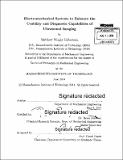Electromechanical systems to enhance the usability and diagnostic capabilities of ultrasound imaging
Author(s)
Gilbertson, Matthew Wright
DownloadFull printable version (44.32Mb)
Other Contributors
Massachusetts Institute of Technology. Department of Mechanical Engineering.
Advisor
Brian Anthony.
Terms of use
Metadata
Show full item recordAbstract
Ultrasound is used extensively in medicine to non-invasively examine soft tissues. Compared to computed-tomography (CT) scanning or X-ray imaging, ultrasound is lower-cost, more portable, real time, and subjects neither the caregiver nor the patient to potentially harmful ionizing radiation, which makes it the imaging modality of choice for many medical applications. Common uses include fetal, vascular, and musculoskeletal imaging, as well as biopsy needle insertion guidance. With 165 million ultrasound exams conducted in the United States annually, and an annual US market of $1.3 billion, improvements to the usability and diagnostic capabilities of ultrasound imaging could lead to significant improvements in medical care. Ultrasound is unique because it generally requires significant contact force with the patient. This has a number of important consequences. The contact forces exerted by the ultrasound probe are generally not known, resulting in images that are acquired at non-repeatable levels of compression, which makes sequentially-acquired ultrasound images difficult to compare and reproduce. Contact force has also been implicated as a major risk factor in work-related musculoskeletal disease (WRMSD) amongst ultrasonographers; currently, clinical reports indicate that nearly 90% of sonographers scan in pain. This thesis explores the mechanical design and experimental evaluation of three novel electro-mechanical systems that could be used to enhance the usability and diagnostic capabilities of ultrasound by measuring and/or controlling probe acquisition state (i.e., contact forces, torques, and angles of orientation). The first system, a hand-held servo-driven ball screw stage, improves image repeatability by applying a constant, programmable contact force between the probe and the patient, and attenuates hand tremors by a factor of 10. The second system, a force/torque-measuring ultrasound probe, was used in the first rigorous clinical study to characterize contact forces and torques applied during abdominal scanning. The third device, driven by a voice coil motor, enables high-bandwidth constant force scanning, and was used to measure the elastic modulus of tissue-an indicator of tissue health-at repeatable pre-load forces.
Description
Thesis: Ph. D., Massachusetts Institute of Technology, Department of Mechanical Engineering, 2014. Cataloged from PDF version of thesis. Includes bibliographical references (pages 283-293).
Date issued
2014Department
Massachusetts Institute of Technology. Department of Mechanical EngineeringPublisher
Massachusetts Institute of Technology
Keywords
Mechanical Engineering.